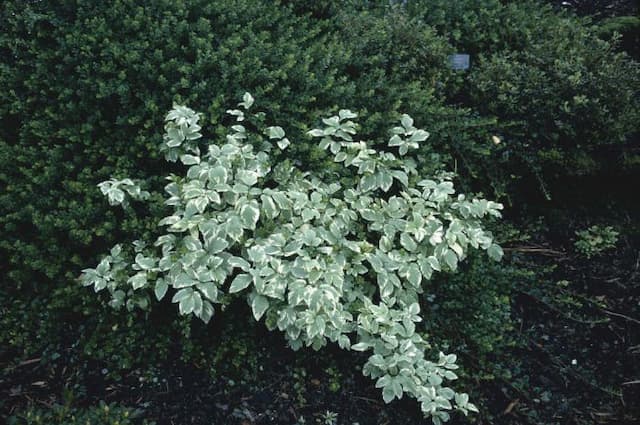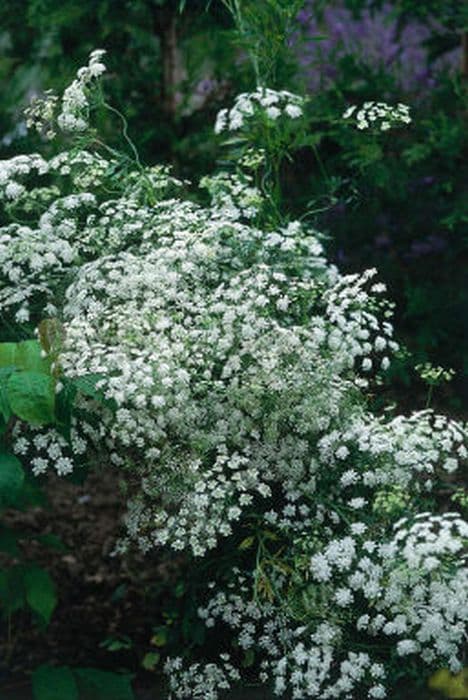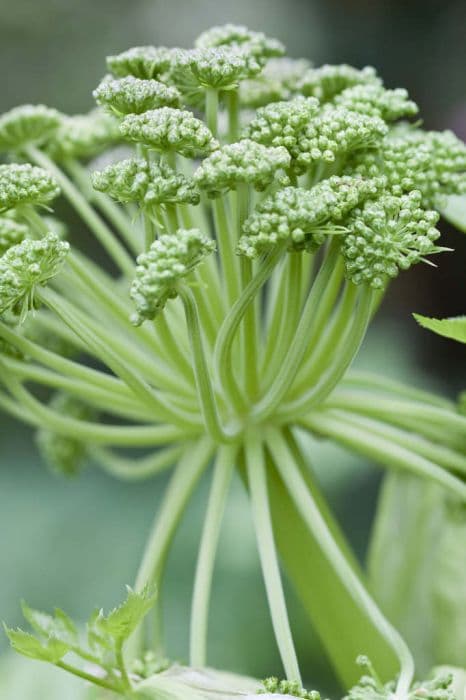Masterwort Astrantia 'Warren Hills'

ABOUT
The Astrantia 'Warren Hills', commonly known as Masterwort, features a unique and enchanting aesthetic that captivates many gardeners. This plant boasts a constellation of star-shaped flowers, which exhibit a pale, blushing shade often described as pink or a soft strawberry hue. The blooms have a papery texture and are clustered together in a dome-like shape, resembling pincushions edged with bracts that flared out beneath them, much like a ruff around the blossom. These bracts add a distinctive contrast to the flower clusters, typically with a greener hue, enhancing the overall appeal of the inflorescence. The foliage of the Masterwort is deeply divided, creating intricate patterns of lush green leaves. The leaves themselves are often palmate, meaning they spread out from a central point like the palm of a hand, with slender, finger-like lobes. The leaves contribute to the plant's attractive mounded form, with the foliage texture being somewhat rough, providing a perfect backdrop for the delicate flowers. Individually, the flowers are quite intricate, with each floret revealing a tiny, cup-shaped formation encircled by more prominent, showy bracts, giving them a multi-layered appearance. This complex structure of the blooms not only adds to the visual interest of the Masterwort but also provides opportunities for light and shadow to play across the plant's profile throughout the day. Overall, the Astrantia 'Warren Hills' combines the charm of its delicate flowers with the robust greenery of its foliage, creating a plant that exudes a cottage garden appeal while maintaining a certain elegance that can complement more formal planting schemes as well. Its bloom period adds long-lasting color and texture to the garden, making it a beloved choice for florists and garden enthusiasts alike.
About this plant
 Names
NamesSynonyms
Masterwort
Common names
Astrantia 'Warren Hills'.
 Toxicity
ToxicityTo humans
Masterwort, to the best of my knowledge is not toxic to humans. No toxicity symptoms or consequences of ingestion of any parts of the Astrantia 'Warren Hills' (Masterwort) plant are commonly reported.
To pets
Masterwort is not known to be toxic to pets. There are no widely recognized symptoms of poisoning for pets ingesting any part of the Astrantia 'Warren Hills' (Masterwort) plant. However, it is always prudent to prevent pets from consuming plants not meant for their consumption, as individual animals may have unique sensitivities or allergic reactions.
 Characteristics
CharacteristicsLife cycle
Perennials
Foliage type
Deciduous
Color of leaves
Green
Flower color
Pink
Height
2 feet [60 cm]
Spread
2 feet [60 cm]
Plant type
Herb
Hardiness zones
5
Native area
Europe
Benefits
 General Benefits
General Benefits- Attractive Flowers: Astrantia 'Warren Hills' features unique pincushion-like blooms that add visual interest to garden beds and borders.
- Pollinator Friendly: The flowers attract a variety of pollinators such as bees and butterflies, promoting local biodiversity.
- Extended Blooming Period: It has a long flowering season from early summer to early fall, providing long-term color to your garden.
- Shade Tolerance: Can thrive in partial shade, making it suitable for woodland gardens or areas with dappled sunlight.
- Drought Resistance: Once established, it shows a degree of drought resistance, reducing the need for frequent watering.
- Low Maintenance: Requires minimal care such as occasional deadheading to encourage reblooming and maintain its appearance.
- Cut Flower: The blooms are excellent for cutting and creating floral arrangements, adding aesthetic value both outdoors and indoors.
- Cold Hardy: Demonstrates good resistance to cold temperatures, making it suitable for gardeners in cooler climates.
- Deer and Rabbit Resistant: Its foliage is not favored by deer and rabbits, which can help minimize plant damage in susceptible areas.
- Works Well in Mixed Borders: Its texture and form complement other perennials and shrubs in mixed garden borders.
 Medical Properties
Medical PropertiesThis plant is not used for medical purposes.
 Air-purifying Qualities
Air-purifying QualitiesThis plant is not specifically known for air purifying qualities.
 Other Uses
Other Uses- Astrantia 'Warren Hills' can be used as a natural dye, providing subtle colors to fabrics and yarns.
- The dried seed heads of Astrantia may be used in crafts for creating decorative wreaths or in dried floral arrangements.
- The flowering stems of Astrantia can be pressed and used in botanical art or herbarium collections for educational purposes.
- Astrantia plants can be used as a living mulch in garden beds to suppress weeds and maintain soil moisture.
- With their intricate patterns, Astrantia flowers make excellent subjects for photography, particularly macro photography.
- Astrantia makes an attractive choice for themed gardens, such as Shakespearean or Elizabethan gardens, due to its old-world charm.
- The plant can serve as a indicator for soil moisture levels; wilting can indicate a need for watering in garden maintenance.
- Astrantia can also be used as a companion plant in the vegetable garden, attracting beneficial insects that may help with pest control.
- Some people use Astrantia in the creation of natural potpourri mixtures, combined with other fragrant dried plants and oils.
- Finally, Astrantia 'Warren Hills' can be used in garden design for its aesthetic foliage, which provides a textured backdrop for other plants.
Interesting Facts
 Feng Shui
Feng ShuiThe Astrantia is not used in Feng Shui practice.
 Zodiac Sign Compitability
Zodiac Sign CompitabilityThe Astrantia is not used in astrology practice.
 Plant Symbolism
Plant Symbolism- Masterwort: The common name of Astrantia 'Warren Hills' is Masterwort. It typically symbolizes strength and power, possibly due to its robust nature and ability to grow in difficult conditions.
- Utility: The plant is known for its historical use in herbal medicine, which can symbolize usefulness or utility.
- Longevity: Masterwort, with its long-lasting flowers, often represents endurance, permanence, or longevity.
- Protection: In folk medicine, it was believed to have protective qualities, thus symbolizing protection or safety.
- Harmony: The balanced shape and structure of the Masterwort's flowers can represent harmony and balance in life.
 Water
WaterMasterwort prefers consistently moist soil, so water it deeply once a week, providing about 1-2 gallons per plant depending on weather conditions and soil type. During hot, dry spells, it may require additional water, possibly twice a week. Always check the soil moisture before watering; it should be moist an inch below the surface but not waterlogged. During winter, reduce watering since the plant requires less moisture. Overwatering is to be avoided to prevent root rot.
 Light
LightMasterwort thrives best in partial shade but can tolerate full sun in cooler climates. It is ideal to place it where it will receive morning sun and afternoon shade, or dappled sunlight throughout the day. Avoid intense midday sun, especially in hot summer areas, to protect the plant from scorching.
 Temperature
TemperatureMasterwort flourishes in a temperature range between 50 and 75 degrees Fahrenheit but can withstand temperatures down to 20 degrees Fahrenheit. Its ideal growing conditions include cool summers and mild winters; excessive heat or cold can stress the plant. Ensure it is protected from harsh winter winds and extremes of temperature.
 Pruning
PruningMasterwort should be pruned to remove spent flowers and encourage new blooms, usually after the first flowering in early summer. Deadheading the plant can also prevent self-seeding if not desired. Cut the flower stems back to the base of the plant. A more thorough pruning can be done in late fall or early spring to remove dead or damaged foliage and maintain plant health.
 Cleaning
CleaningAs needed
 Soil
SoilMasterwort 'Warren Hills' thrives in rich, moist, well-drained soil with a pH close to neutral, ranging from 6.5 to 7.5. For the best soil mix, combine equal parts of garden loam, compost, and leaf mold to create a fertile and slightly humusy environment.
 Repotting
RepottingMasterwort 'Warren Hills' generally doesn't require frequent repotting as it is not commonly grown in containers. However, if grown in pots, repot every 2-3 years in spring.
 Humidity & Misting
Humidity & MistingMasterwort 'Warren Hills' prefers average to high humidity levels but is adaptable to typical outdoor humidity conditions.
 Suitable locations
Suitable locationsIndoor
Ensure bright indirect light and high humidity for Masterwort.
Outdoor
Plant in partial shade, keep soil consistently moist.
Hardiness zone
4-7 USDA
 Life cycle
Life cycleAstrantia 'Warren Hills', also known as Masterwort, begins its life cycle when seeds germinate in moist but well-drained soil, typically in spring. After seedling establishment, the plant enters a vegetative stage, where leaves develop into a clump of deeply lobed, green foliage. In early to midsummer, Masterwort progresses to the flowering stage, featuring branched stems rising above the foliage with umbels of tiny, pale pink flowers surrounded by a ruff of bracts. Following pollination by insects attracted to the flowers, the plant sets seed in late summer to autumn. As a perennial, after setting seed, Astrantia 'Warren Hills' enters a dormancy period in winter, where above-ground growth dies back with the roots surviving underground. With the return of favorable conditions in the subsequent spring, the plant regrows from the rootstock, completing its cycle and beginning anew.
 Propogation
PropogationPropogation time
Spring to Summer
Propogation: The Astrantia 'Warren Hills', commonly known as Masterwort, is typically propagated through division, which is a popular and effective method. The best time to propagate this perennial plant is in the spring or early fall. The process involves carefully lifting the parent plant from the ground with a garden fork, shaking off excess soil, and gently teasing apart the clumps of roots. Each section that is separated should have at least a couple of growth points or shoots. These individual divisions can then be replanted at the same depth they were originally growing, spaced about 12 to 15 inches (30 to 38 centimeters) apart to allow room for growth. Watering thoroughly after planting helps to settle the soil around the roots and aids in the recovery and establishment of the new plants.









